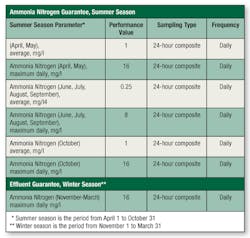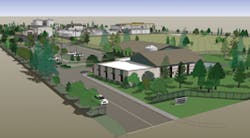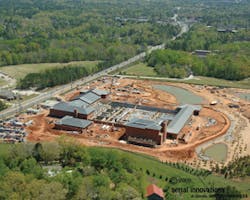Increasingly, municipal water managers are faced with the consequences of development which, in some areas, is putting a greater burden on dwindling natural groundwater resources and—in some cases—is further threatening the viability of surface water bodies with already excessive levels of pollutants. An increasingly viable and cost-effective solution is onsite wastewater treatment that allows a dedicated reuse of wastewater in applications such as irrigation. Not only does this strategy take a burden off of natural potable water supplies, but it also can improve the quality of those supplies downstream.
Four recent or ongoing large-scale water reclamation projects demonstrate that a major investment in onsite wastewater treatment can overcome these environmental and financial constraints concurrently.
Regional WRF, Spokane County
Spokane County, WA is making a major investment in a regional water reclamation facility (WRF) as part of a long-term water-conservation initiative that includes reducing the burden on the county’s sole-source aquifer as a potable water supply while helping to clean up the impaired Spokane River. The county’s new $145-million regional WRF—which broke ground in June 2009—was to become operational by late 2011. It is expected to keep pace with anticipated regional population growth and resulting increased water demands, in order to meet the county’s septic tank elimination goals, while improving water quality and the environment, and reducing phosphorus and other nutrient discharges to the Spokane River.
Bruce Rawls, director of utilities for Spokane County, explains the county’s multifaceted water-conservation initiative and how the WRF fits into it. “We’ve had a septic tank elimination program since 1982 because we’re over a sole-source aquifer, and that’s our sole source of drinking water,” says Rawls. “In 1999, we recognized that we were not going to have enough [sewer] capacity to eliminate all of the rest of the septic tanks, hook them up to centralized treatment, and provide for regional growth over the next 20 years, so we began the planning and evaluation of alternatives. We came onto the notion of building a wastewater treatment plant. Then, the Spokane River got listed [by the State of Washington Department of Ecology] as impaired for dissolved oxygen because of excess nutrients, particularly phosphorus.
“As we began to work our way through the phosphorus issue, and we were dealing with the regulatory agencies and the conservation groups, one of the things we realized was that, if we reduced the pounds of phosphorus relative to the volume of water, it would be beneficial,” he adds.
Because reducing sewage—from which contaminants would eventually make their way into the river—would reduce phosphorus levels, the county launched a plumbing-fixtures upgrade program that included low-flow toilets and showerheads, and rebates for low-flow washing machines.
A larger-scale means of protecting the river from sewage contaminants, while reducing the burden on the county’s sewage treatment facilities, will be reclaiming a high volume of sewage effluent for reuse. In January 2009, Spokane County Commissioners awarded Englewood, CO-based engineering, procurement, construction, and operations firm CH2M Hill a contract to begin the designing and permitting for the regional WRF, which will have an 8-million-gallon-per-day (mgd) capacity with expandability to 24 mgd. CH2M Hill has a design/build contract, and also a 20-year plant maintenance contract, upon startup. The treatment system will utilize GE Water membrane bioreactor (MBR) plant technology that will provide high solids removal and effluent filtration, allowing reuse of the effluent for irrigation throughout the county and reducing the volume of phosphorus and other pollutants in the Spokane River.
MBR technology is an effective means of facilitating water conservation via reuse. It combines conventional activated sludge processes and hollow-fiber membrane filtration to restore wastewater to a level of quality that allows it to be safely discharged to sensitive water bodies or reused in municipal or industrial applications. Reclaiming wastewater with MBR technology allows communities to substitute recycled water for potable water and reduce the demand on natural water resources. Reinforced hollow fibers like those in the GE ZeeWeed system are developed for the high solids environment of a bioreactor.
The MBR plant in Spokane County will utilize immersed hollow-fiber membranes to separate particles from water. The manufacturer claims that the system uses up to 60% less chemicals and 30% less land, while producing 35% less residual waste than conventional water treatment systems. Using low-pressure suction, the system’s membranes draw in clean water through billions of microscopic pores and trap nearly all particles at the surface. The outside-in flow path eliminates the need for a pressure vessel, and the direct immersion of effluent into process tanks gives the system a compact footprint and requires relatively few components and maintenance.
The Spokane County Regional WRF will include a headworks equipped with fine screens that will filter out sand, gravel, and other abrasive material. Chemically enhanced primary clarifiers will also separate solids from the effluent. The solids will be treated in an anaerobic digester before all liquids are pressed out and the material is run through centrifuges and stored for shipment via truck for fertilizing applications. The effluent will enter biological aeration basins and undergo the secondary treatment process of being pulled through the MBR membranes. Following this, the effluent will be disinfected via chlorination.
According to Rawls, the plant will reduce phosphorus to lower levels than at any treatment facility in the US: less than 50 parts per billion.
Dave Moss, water reclamation manager for Spokane County, adds that testing indicates incoming phosphorus levels of 6,000-7,000 parts per million. Pending the final permit, the limits on ammonia nitrate (see table) and carbonaceous five-day biological oxygen demand (CBOD) (daily maximum of 2 milligram per liter [mg/l] throughout the year) also were low. However, the membrane system will keep these pollutants below the prescribed limits.
“Not only are we required to hit a very, very low level for phosphorus, but also a very, very low level for ammonia and CBOD,” says Rawls. “When you combine all of these exceptionally low levels, we’ve got one of the most expensive treatment plants per gallon of treated water in the country—not just to construct but also to operate.”
Potentially, all 8 million gallons of reclaimed water could be reused, says Rawls. “Part of our capital improvement program is to go out and find people willing to reuse the water,” he says, adding that this part of the program is in the early stages.
Moss adds: “There are four main opportunities for reclaiming the water. There is industrial reuse, we’re looking at wetland restoration, we’re looking at urban irrigation—golf courses, parks, schools, etc.—and we’re looking at groundwater recharge.”
The WRF will also include three buildings to be used for non-processing functions: an operations center with administrative space and lab facilities; a water resource center with a conference room, training room, and educational displays; and a maintenance building. Several of the facility’s buildings will be constructed to the US Green Building Council’s Leadership in Energy and Environmental Design Silver requirements. Additionally, the plant’s sustainable design will allow energy recovered through digester gas production, process heating, and cogeneration systems to generate electricity to help run the facility.
Peoria Butler Drive Water Reclamation Facility
Peoria, AZ, USAWinner: Large Project of the Year–TBA
Sept. 2009
WateReuse Association
Winner: Large Project of the Year
WateReuse Association/Arizona
Winner: Public Works Project of the Year
Environment (more than $75 million) category
American Public Works Association (APWA)
Winner: Project of the Year
Environment (more than $75 million) category
APWA/Arizona
Winner: Wastewater Project of the Year
AZ Water (formerly Arizona Water & Pollution
Control Association)
Winner: Architectural Merit
American Concrete Institute/Arizona Chapter
Winner: Service to Communities–Municipal
Best of the West Awards–2008
WESTMARC
Johns Creek Environmental Campus, North Fulton County
Take suburban sprawl, add a sustained drought, and you get fast-growing north Fulton County, GA, where the need to ease the burden on existing water supplies is dovetailing with increasingly scarce land for wastewater treatment. The combined answer to this problem has been to significantly increase the average daily wastewater-treatment capacity in the area via advanced MBR technology—and do it with minimal land consumption, noise, and sight pollution.
A decline in available potable water sources, largely due to a long-term statewide drought that began in 1998, has created a water conservation challenge in the Atlanta area. Several tributaries of the Chattahoochee River have virtually dried up and made it more susceptible to pollution. With the river’s capacity shrinking and its burdens increasing as the regional population is expected to double by 2030, the Metropolitan North Georgia Water Planning District (MNGWPD) was created to address the preservation of water quality and extending water supply in the 16-county area. Shortly after its inception, the MNGWPD worked with the EPA and the state Environmental Protection Division (EPD) to analyze the total pollution load going into the Chattahoochee River and used the data to make future projections.
Concerns were raised because several counties in the MNGWPD were approaching the discharge limits of their National Pollutant Discharge Elimination System (NPDES) permits, and more than 1,000 miles of surrounding rivers and streams had been classified as impaired, according to the EPA’s assessment of the river’s pollutant loading. Largely due to the drought, the river is shallow in places and more susceptible to pollution in those areas and during the hot summers, when the demand on the river for irrigation water is highest. The district, along with EPA and the Georgia EPD, analyzed the total pollution load going into the river and projected future loads. Several counties in the district were approaching the discharge limits in their NPDES permits and, all told, more than 1,000 miles of rivers and streams in the region were classified as impaired per EPA pollution criteria.
Four of the counties—Forsyth, Fulton, Hall, and Cherokee—constructed MBR treatment plants for water reuse that rely on GE ZeeWeed MBR system technology. Another county in the district, Gwinnett, also added ZeeWeed membranes to provide tertiary ultrafiltration for 50 mgd of secondary effluent from a conventional plant, and as of spring 2009, a large MBR was also under construction in the county’s Yellow River WRF. The system’s hollow-fiber membrane design has proven to provide an effluent filtration level that allows large-scale water reclamation and lessens the burden on the river’s potable water supply. In Fulton County, the system is a key component of a water-conservation plan intended to reduce potable water demand by 10%, in addition to other measures that are expected to yield water savings of about 11%.
Spokane County’s new $145-million regional WRF will keep pace with growth, while improving the water quality of the impaired Spokane River.
In north Fulton County, the Cauley Creek WRF has an average daily flow (adf) of 5 mgd and the Johns Creek Environmental Campus plant has a 10.9-mgd adf and a 15-mgd maximum flow; working in tandem, these facilities promise to significantly reduce the burden on the river. Just as significantly, they serve as examples of how such facilities can be constructed in close proximity to neighbors with minimal nuisance perception. This proximity also reduces costs that otherwise would be incurred for piping reclaimed water across large distances.
Phase I of the Cauley Creek Water Reuse Facility was commissioned in April 2002 to reduce the burden on Cauley Creek, a Chattahoochee River tributary, and the area’s main municipal sewer. The ZeeWeed MBR plant was the first of its kind in Georgia and was designed to treat an adf of 2.5 mgd. A Phase II facility was commissioned in April 2004 that increased the capacity to 5 mgd and added biological phosphorus removal to minimize chemical consumption, mixed liquor surface wasting to minimize scum and foam in the aerobic zones, and a ZeeWeed sludge thickener to minimize the aerobic digester volume. Treated effluent from the facility is used to irrigate local golf courses, subdivisions, schools, and churches. The facility was designed to resemble a dairy barn, including a white picket fence, a rooster weather vane, and life-size plastic cow, to blend into the surrounding agricultural area.
Within roughly a half-hour drive of the Cauley Creek WRF is the 43-acre Johns Creek Environmental Campus,
Scour air and permeate piping above immersed membranes in membrane gallery of the Butler WRF
which was to include a GE ZeeWeed MBR plant with a 15-mgd capacity due to go online in mid-2009. The new plant is replacing an existing 7-mgd conventional wastewater treatment plant on the site. The membrane filtration system is designed to remove solids and treat effluent prior to final ultraviolet effluent disinfection. The new reuse distribution network for Johns Creek will be joined with the existing reuse distribution system from Cauley Creek, forming a 15-mile primary distribution system.
In order to mitigate pollution in the Chattahoochee River, the MNGWPD set strict effluent discharge standards for new and expanding plants, sharply reducing allowable limits on several pollution measures. The Fulton County plants have cut pollutants in the effluent to levels well within the limits: for example, the Johns Creek plant is reducing total phosphorus to less than 0.13 mg/l, compared with a limit of 0.3 mg/l. Additionally, the plant is designed to keep nitrates at or below 8 mg/l in anticipation of possible future limits in lieu of current limits. The MBR system’s solids-removal capability is also reducing total suspended solids to less than 1 mg/l versus a state requirement of 5 mg/l and turbidity (0.2 nephelometric turbidity units versus a state limit of 3 NTU).
Theoretically, the entire 15-mgd volume of water that will be reclaimed between the two plants can be used for non-potable applications, including irrigation. Potential irrigation applications include schools, churches, and golf courses.
Like the Cauley Creek WRF, the Johns Creek facility is designed for minimal aesthetic disturbance of its surroundings. The latter facility, surrounded by million-dollar single-family homes and commercial properties, is designed to resemble a historic cotton mill. The Environmental Campus will also include educational facilities that will be used to convey the benefits of MBR technology to the public via tours, seminars, and operator training courses.
Chennai Petroleum Company WRF, Tamil Nadu
The Chennai metropolitan area of India’s Tamil Nadu state has experienced severe water shortages due to below-average annual rainfall in recent years. As a result, Chennai has used several alternative water sources, such as surface water runoff, local aquifers, and water from the Krishna River in Andhra Pradesh. However, much of the city’s water supplies are polluted by sand mining and textile and leather tanning plants. The water shortage adversely affected the Chennai Petroleum Company Limited (CPCL), which was forced to cut back its Manali Refinery operations in the late 1980s.
The 43-acre Johns Creek Environmental Campus is combining with another water-reclamation facility in north Fulton County for a 15-mgd-plus water-reclamataion capacity.
In order to increase the amount of available water, CPCL constructed a new wastewater reclamation plant that took municipal sewage from the Chennai Metro Water District and treated it to a sufficient level for use in the refinery. This plant represented the first of its kind in the Asian refinery industry and operated successfully for more than 10 years, reducing the demand on Chennai’s natural water resources. Still, system productivity was less than ideal because treatment required several steps. Secondary treated sewage was first pumped from the plant through a 3-kilometer pipeline and into a 3 million-gallon reservoir. From there, the treated sewage passed through a biological treatment system and was stored in a 2.5 million-gallon intermediate storage pond. Lime was then added to the wastewater and the sewage underwent pressure sand filtration, ammonia stripping, break-point chlorination, multi-media gravity filtration, and cartridge filtration. Finally, reverse osmosis (RO) removed salts and very small organic compounds from the water.
In the late 1990s, company management sought to reduce the number of treatment steps, as well as extend the life of the RO membranes and make the RO system work more efficiently. In addition, management wanted to reduce both the turbidity and the silt density index. CPCL settled on ultrafiltration (UF) hollow-fiber membranes from Koch Membrane Systems Inc. to pretreat the feed water to the plant’s RO system. The membrane system, which is part of the largest wastewater reclamation plant in India, was designed to remove very small contaminants in the feed water, including nearly all suspended solids, colloidal particles, and microorganisms.
In November 2004, CPCL commissioned its new system, which features Koch hollow-fiber UF membrane cartridges. The system has six cartridge racks with 18 10-inch-diameter Targa PMC UF membrane cartridges, for a total of 108 cartridges. The cartridges contain polymeric, hollow-fiber membranes that have a nominal molecular weight cutoff of 100,000 Dalton, operate over a pH range of 1.5—13, and tolerate oxidizing agents including chlorine and peroxide. The treated water also has very low turbidity of less than 0.1 NTU and an SDI below 2.
According to Koch, the membrane cartridges were selected because they offered relatively tight membrane porosity and a higher membrane area per module; as a result, a smaller system with lower pump capacities was required. This smaller size allowed minimization of system floor space area.
The plant operates at 90% water recovery with a production capacity of 430 cubic meters of treated water per hour. Another upgrade to the operation was the use of Koch RO membranes in a recent RO plant upgrade. The new membranes are expected to have a life of four to five years and require fewer cleaning cycles than the previously used membranes, in addition to producing a higher-quality permeate with fewer total dissolved solids (TDS). The lower TDS was important because CPCL has an ion-exchange system downstream from the RO plant and without high-quality effluent, the company would have had to increase the capacity of the ion-exchange system—a tall order due to space limitations.
Butler WRF, Peoria
Cost savings and aquifer recharging were the primary motivations that led the City of Peoria, AZ, to construct the $110 million, 10-mgd Butler WRF from June 2006 to July 2008. The city had sought to ensure that water supplies would keep pace with future population growth while finding a lower cost alternative to paying neighboring Tolleson, AZ, for treatment at that city’s wastewater facility. It would prove to be the largest capital-improvement project in the city’s history.
“Similarly to other communities in the area, Peoria had been sending its wastewater to another treatment plant where it owned capacity and it was paying an annual cost for treatment, and that facility was coming up for some major renovations,” notes Brad Hemken, project director at the Butler WRF for engineering, consulting, and construction firm Black & Veatch.
“We did an analysis for them and looked at their alternatives, and it proved to be cost-effective to discontinue their ownership at the other facility, keep that wastewater in Peoria, and build this water-augmentation facility,” he says.
Stephen Bontrager, utilities director for the City of Peoria, echoes Hemken’s sentiment. According to Bontrager, an analysis determined that building its own WRF would allow the city to retain water credits and sustain the city’s economic development.
Like a conventional wastewater treatment plant, the Butler WRF clarifies large solid materials and filters out sand. But it also uses a GE ZeeWeed MBR ultrafiltration system to filter out smaller solids and contaminants. Hemken points out that the membranes, which have a pore size of 0.4 micron, reduce turbidity to 0.1 or lower NTU, compared with a conventional plant that would provide 2 NTU or lower. The facility’s capacity can be increased to 13 mgd with the addition of several membrane cassettes. The final treatment step is ultraviolet disinfection.
Hemken adds that the system suits the facility, which is being constructed next to a park, because it allows a small plant footprint.
“There are basically two camps with these systems: the hollow-fiber membranes, which the [ZeeWeed] membrane falls into, and flat-sheet membranes,” he says, adding that the city received one submittal for a hollow fiber membrane system and another for a flat sheet membrane system. “There is a fair amount of difference between the camps in terms of square footage of membrane per physical square footage of plant.”
While locating the facility close to the origin of the wastewater will reduce costs associated with installing pipe, its proximity to residents less than a mile away and the planned park necessitates odor-control measures for the facility. All major process units are enclosed to confine odors, and odor-control technology is also used. Screening and grit removal equipment and biological treatment basins are enclosed, exhaust from the basins is treated with activated carbon, and a chemical wet scrubber is also used for odor control.
“That’s another advantage to this small footprint—there’s less structure to cover and less air to scrub through the odor-control system,” says Hemken.
The facility blends into the surrounding area; much of the plant was built below ground level and is bordered on all sides by a landscaped buffer. The facility also has low-profile compact structures that are architecturally compatible with their surroundings. The treatment area of the facility is also hidden from public view on two sides.
“This is now a technology that people can be comfortable with and don’t need to be afraid of,” argues Hemken. “There are a number of advantages with the footprint and high-quality effluent. The city is pleased that it made the investment to augment their water resource needs.”






